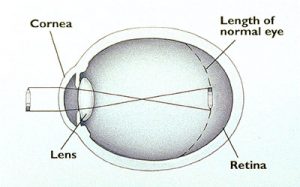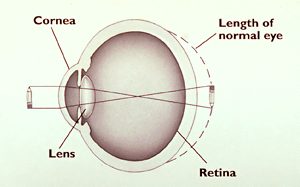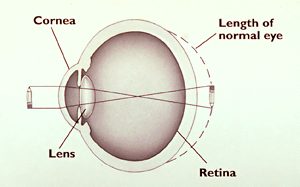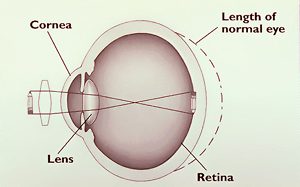TYPES OF REFRACTIVE ERRORS:
NEARSIGHTEDNESS (MYOPIA): Distance vision is impaired when the eye is too long or the cornea too steep. This causes light to focus before it reaches the retina. Close objects look clear (hence “nearsighted”), but distant objects appear blurry.
- In myopia, images at a distance are blurred, whereas close objects are in focus.
- Schematic drawing of a myopic eye. The image of the pencil is actually focused in front of the retina.
- With a “minus lens” correction, light rays now are focused directly upon the retina for a sharp image.
Myopia is extremely common and is the most common form of refractive error in children. It is common for myopia to progress during adolescent years and finally taper off in the early to mid-20’s. Depending upon the degree of myopia, regular exams are usually in order. Most cases of myopia are mild and are uncommonly associated with other eye problems. High myopia however can have associated problems usually due to the eye becoming very elongated. When this happens, intraocular structures such as the retina can become thin and will need monitoring on a periodic basis for hole formation or tears. Other problems such as macular degeneration, retinal detachment, and glaucoma can develop with high myopia.
Correction for myopia takes a “minus” lens which is a spherical lens that takes the natural “near” focal point of the eye and moves it out to infinity so that the eye can see off at a distance. The lenses look normal for the most part. However, as the amount of myopia increases, lenses can become rather thick and make the eyes look small. Also, images through the lenses may seem small to those wearing myopic correction. Much of these effects can be greatly helped or reduced with proper grinding and fitting of glasses.
Also, contact lenses are an option. (Click on to Common Glasses Problems and Solutions for helpful suggestions about problems you may be having with your glasses.)
FARSIGHTEDNESS (HYPEROPIA):
Close vision is impaired, with some impairment of distance vision, as well. The eye is too short or the cornea too flat. Therefore light rays are not yet in focus when they reach the retina, so images appear blurry. Unlike myopia (nearsightedness), hyperopia (farsightedness) is usually well tolerated during younger years and generally doesn’t become a problem which requires correction until later on in adult years. Some children however are very sensitive to hyperopia and can develop a form of strabismus called accomodative esotropia commonly seen by age 18 months to 2 years old. This form of strabismus is often correctable with glasses.
- Here, the eye is “too short” with light rays falling behind the eye.
- With a correct “plus” lens, the image of the pencil now falls squarely upon the retina.
Correction for hyperopia requires a “plus” lens which will help light rays “converge” upon the retinal surface properly. Some people are concerned that large amounts of hyperopic correction make the eyes look large as though they are magnified. With proper grinding and fitting of glasses, these unwanted effects can be reduced greatly. Contact lenses for many are an excellent choice. See Optical Services.
ASTIGMATISM:

Uncorrected astigmatism impairs both distance and near vision. Depending on the degree of astigmatism, objects may appear distorted.
Unlike myopia or hyperopia where there is only ONE abnormal focal point, in astigmatism, there are at least 2 abnormal focal points (called “regular astigmatism) which do not focus properly on the retina. In cases where there are more than 2 abnormal focal points, the astigmatism becomes irregular.
In regular astigmatism, the cornea and or lens surfaces of the eye are not perfectly round, but rather elliptically shaped like perhaps a football with a flatter curve to it and a steeper curve. This type of curvature of the cornea and/or lens causes light to focus on more than one point in the eye. These two points of focus can lie anywhere in relation to the retina (either both in front of the retina, both in back of the retina, one in front and one behind, etc.).
Correction for astigmatismIn requires a lens that can neutralize both focal points. This type of lens is called a spherocylinder lens as opposed to lenses for myopia or hyperopia called spherical lenses. To the naked eye, a spherocylinder lens looks no different than any other type of lens. Going into astigmatic correction for the first time, however, can require some time to adjust, especially for older adults. Also for those experienced with astigmatic correction, a change in the amount of correction or the orientation of the lens can cause adjustment difficulties. Images at first may seem somewhat slanted, and walking or reading may create the sensation of going “uphill.” With properly fitted glasses, these effects usually disappear with time although at times, the astigmatic correction may need to be adjusted.
Unlike “regular” astigmatism, “irregular” astigmatism is usually due to diseases processes of the cornea in which the corneal surface itself is irregular or warped. This type of astigmatism cannot be neutralized with glasses. Rigid contact lenses can be helpful, and as a last resort, replacement of the cornea itself (corneal transplant) can be done. Causes of irregular corneal astigmatism can include chemical burns, corneal scars, corneal injuries, and corneal diseases such as keratoconus.
PRESBYOPIA (aging eyes):
When young, the lens of the eye is soft and flexible, allowing people to see objects both close and far away. After the age of 40, the lens of the eye becomes more rigid, making it more difficult for the lens to change its shape, or accommodate, to do close work such as reading, doing needlepoint, playing the piano, or doing computer work.
This condition is known as presbyopia and is the reason reading glasses or bifocals are necessary at some point after age forty.
Correction for presbyopia requires careful thought to minimize the adjustment period and to smooth the transition, especially if bifocals are going to be used. The decision to transition into bifocals will depend upon a variety of circumstances including lifestyle, nature of work, refractive error, and other factors.
For example, if a patient has good distance vision with little or no distance correction needed, then reading glasses may be all that is required. They are simple to use and
require little adjustment. However “full-view” readers will cause blurred distance vision since they are designed only for reading activities. With them on, reading the newspaper will be heavenly, but the TV news will be blurry unless you take them off. In this case, “half-glasses” readers (“granny-glasses”) which sit low on the nose will allow one to read while looking down through the lenses, and will also allow distance vision when looking up over the frame. Many people, however, do not like the cosmetic aspect of half-glasses.
Fortunately with modern day frames, proper fitting, and smaller lenses, reading glasses can be very versatile AND attractive. These frames will allow one to wear the glasses in normal position when doing computer work, or in a low position to read while preserving their distance vision.
For those who need distant correction, who have the need for safety glasses, or who do not like reading glasses, bifocal glasses are necessary. Bifocals allow one to focus both at a distance and at near, and come as either a “line” (traditional) bifocal or a “no-line” style. While most patients now are preferring a “no-line” design, each has
its advantages and disadvantages depending upon many factors.
TRADITIONAL BIFOCAL vs. NO-LINE (PROGRESSIVE) BIFOCAL
|
ADVANTAGES
|
DISADVANTAGES
|
|
|
“NO-LINE (PROGRESSIVE) BIFOCAL” vs. TRADITIONAL BIFOCAL
|
ADVANTAGE
|
DISADVANTAGES
|
|
|
For further discussion of the above, please click to Common Optical Terms.
Generally, people who have worn glasses for years adjust to bifocals rapidly. Those who use bifocals just for reading may have a difficult time wearing them while moving about. No matter what form of bifocal, there is usually adjustment that a newcomer
experiences. Difficult activities include stepping off curbs, going up or down stairs, and walking in general. Certain types of bifocals may be better suited to certain types of work, and bifocal segments can be located either below (which is the norm), or even in the top part of the lens which is sometimes required by postal clerks, carpenters, electricians, or others who do work overhead.
Your ophthalmologist will be able to direct you on what is best for you. Remember too that how well you see will also depend upon the quality of workmanship of the
glasses. Please click to Common Glasses Problems and Solutions for a discussion on problems you may be having with your glasses and how to remedy them.





